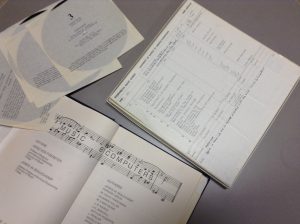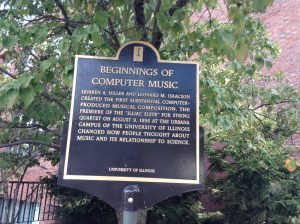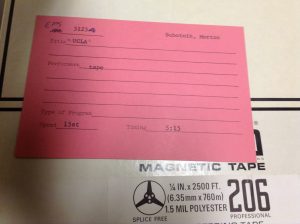What began as me trying to put my thoughts into words has turned into a full blown treatise. Thanks for reading! -DL
Introduction
Right now, we are in a crucial time where we must decide the future of the collection. There are two distinct preservation methodologies which will drive how this collection is preserved and accessed for all future generations.
These two strategies, which I will expound upon in more detail shortly, are essentially as follows:
- Preserve ALL of the materials in a way that provides a similar way of access for the EMS as they have right now. At the moment, the Director of the EMS can hypothetically walk into that closet, grab a tape, and put it on the deck. The preservation goal would be to recreate this experience as closely as possible.
- The second strategy is that you preserve and provide access to what is unique in the collection and the original manner of accessing the collection is not preserved because it is not particularly important. Since some of this material may be available elsewhere, the EMS can use those outlets to access the materials without going through all of the trouble of digitizing and storing those materials.
Each strategy has a benefit and drawback. I am a proponent, for reasons that I will talk about shortly, of the first method but it won’t be easy to do.
Preservation Methodologies
I believe that access to this collection, in its entirety, is essential to both maintaining a link to EMS’ history as well as providing important instructional materials. In the past, the Director of the EMS could easily access these recorded materials.The former Director told me that he used this collection to both provide materials for both instructional purposes as well as storage for master recordings associated with the EMS (and electronic music in general).
The collection represents decades of history, both in what is actually on the tapes but also, from a pedagogical viewpoint. These tapes represent what the EMS thought was important materials for use in advancing their their educational mission. Not to wax too poetic, but I believe, that this collection, as it is, represents a sort of multi-decade playlist of the EMS. To be cut off from this access would be damaging both to the institutional memory of the EMS as well as their educational mission.
In an ideal world, where there was unlimited funds and resources, we would create a digital graphic interface that would look just like that closet storage space. One could click on each item and you could see an image of the tape’s box, listen to the recording, see the metadata, etc. The digital experience would very closely replicate the current physical experience.
Unfortunately, I will never have the time to develop and complete that dream. I think in recognizing this ideal though, it is clear what my vision is.
Which brings us to our second methodology, which focuses on preserving what’s important to the collection while providing changed ways for the EMS to access the collection. Such a methodology asks many questions of the “preserve everything” strategy:
For example, Some of this material is available elsewhere and people inside the EMS can access it there. How important is it that all of this information is actually available, in one place, to the EMS. In fact, does anybody even use the current EMS archive anymore?
Since there’s going to be copyright issues, which will prevent those outside the EMS from accessing this collection, is it even worth it to put in so much work for a project with such a limited audience? Why go through all of this trouble which will involves countless hours of work?
With the shortage of staff, is preserving the entire collection in its entirety even possible?
Additionally, since there are several units on campus with interest in this project, can we make everyone happy?
Those are all tremendously essential questions and it is possible, that I’m overvaluing the original value regarding the current method of accessing this collection. I have been known to have a romantic vision about these sort of preservation issues.
That said, I do believe that there is value in digitizing the recordings that may be available elsewhere. Such recordings may be easier to access for the EMS than going down to the music library (and perhaps having to listen to materials in the library only). Furthermore, the recordings in the EMS may be better quality than those currently available elsewhere. For example, those same compositions hosted online may be of inferior fidelity than what the EMS has. Furthermore, an LP in the Music Library may be scratched, again providing a lower quality of play than the tapes of the EMS. Finally, it is possible that recordings in the Music Library or online may be of different performances than what have been recorded by the EMS. Although we may think, at first, that the recording is widely available, it may in fact be unique.
I also believe, due to the historical and cultural significance of the EMS, that such a dedication to preserve these materials, as a whole, is justified. I could speak much more on the cultural significance of the EMS but I’ll leave that argument for another day.
That all said, I may have a solution that will be acceptable to all parties. I am not sure if I could get all of the moving parts to sync up but it may be worth a try.
Unfortunately, I will not be at the University long enough to see this project to completion. There are just too many hours of recordings to catalog, digitize, and archive (with the appropriate metadata). The Preservation Unit and the Sousa Archives both want the tapes to be digitized under their own auspices. The EMS would love to have the space that these tapes are taking up. Everybody involved wants to see the collection transferred somewhere with a long term preservation plan, a disaster plan, and some level of access.
Any preservation plan would be up to the Director of the EMS, but assuming that he does want to preserve the collection as a whole while providing access to the collection it its entirety, I think there is an option which may make everyone happy.
First, I complete the item-level evaluation of the EMS items and I catalog everything. I also document the original order of the the closet with photographs, just so we know the context of how these materials were originally accessed.
Through this, we identify what is unique, master recordings, and most in danger. We could then, have Josh or Scott digitize those prioritized recordings. The rest of the recordings could be digitized as part of an Independent Study or Practicum through the University of Illinois Information School (formerly the Graduate School of Information Science). I believe that I could establish, with the help of the Information School administration, such a program where we could get a qualified graduate student (or two) to work on these materials. Such graduate students could work with the current Director of the EMS as well as other Preservation experts on campus, like Josh Harris and Scott Schwartz. Such students would learn about preservation, metadata creation, and collection development. They would be getting hands-on experience and course credit in exchange for their time.
During this process though, I would argue that the collection should stay together. When the project is completed. As much of the physical collection can enter the Sousa Archives as their Director sees fit. The Sousa Archives can also address copyright and general accessibility issues to the public at that point.
Although it may pose a bit of a challenge, it may be possible to move the entire collection out of the EMS while this digitization project is taking place (so the EMS can utilize this space). Again, I think there is value in keeping the entire collection together until this project is complete.
Upon completion, the EMS would have access to a database, probably in the form of a hard-drive (which would have backups). They would have access to all of the materials that they currently have access to. The footprint of the collection will disappear from the EMS but access to the materials will remain unchanged (or in reality, it may actually be better since you won’t have to be near a tape deck to listen). Through this project, I believe a lineage would be maintained helping to bridge the EMS’ past with their changing future. Additionally, I also believe such access would greatly benefit the teaching mission of the EMS.




